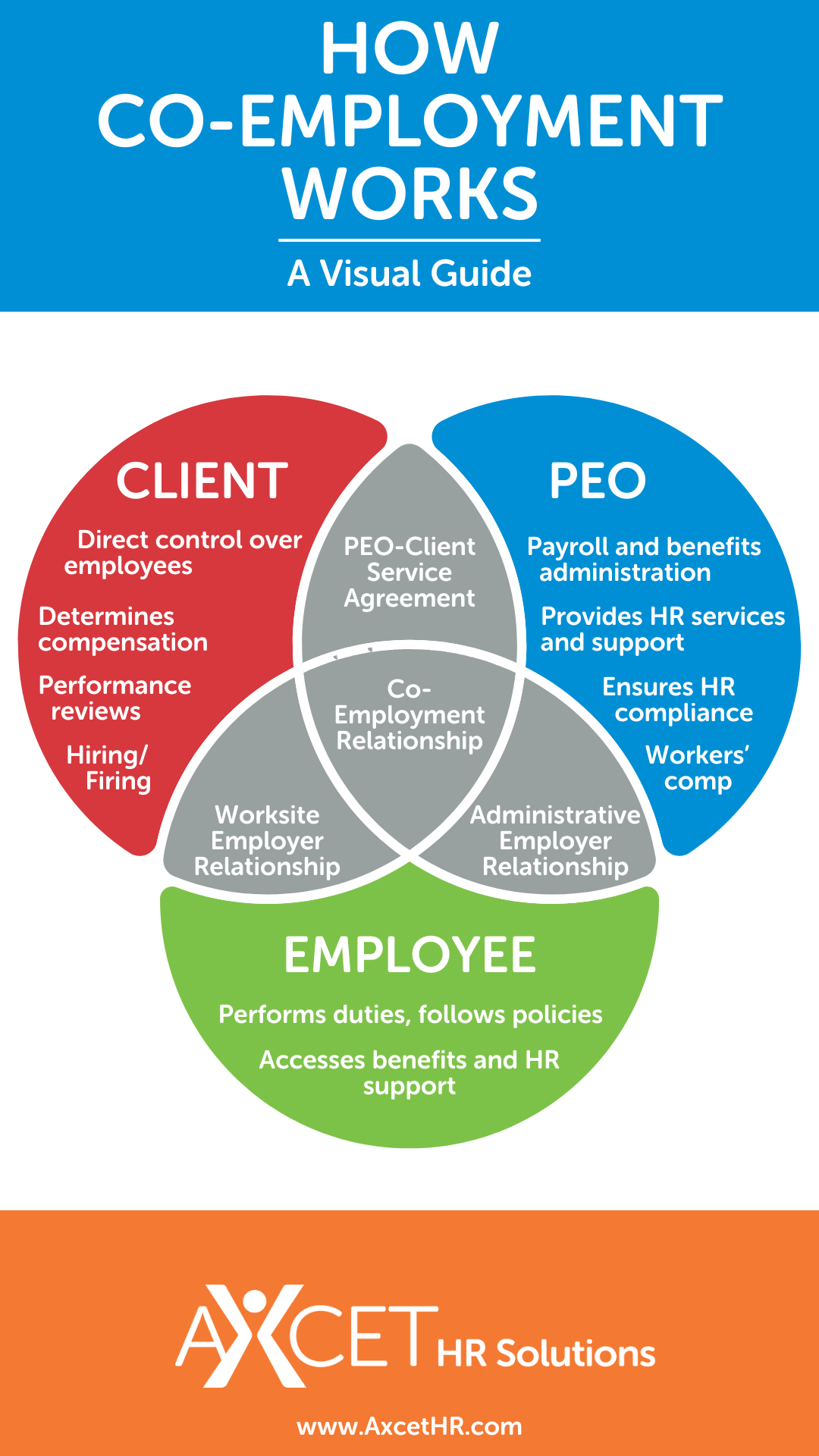By
Jeanette Coleman, SPHR & SHRM-SCP
on
Oct
24,
2025
7 min read
0 comment(s)

Co-employment is the foundation of the professional employer organization (PEO) model — a shared HR structure that allows small and mid-sized businesses to offload time-consuming tasks like payroll, benefits administration and compliance, while retaining control over day-to-day operations.
In this guide, we’ll explain what co-employment is, how it works in a PEO partnership, the benefits it provides and why it’s a smart move for growing businesses that want strategic HR support without the overhead of managing it all alone.
Co-employment is a contractual arrangement where a company partners with a PEO to offload complex HR tasks such as payroll processing, tax filings and compliance. This partnership allows business owners to focus more on their core operations while leveraging the expertise of seasoned HR professionals.
In co-employment, the PEO becomes the administrative employer, handling a wide range of HR-related tasks. These include not only payroll and tax filings but also employee benefits management, workers’ compensation issues, and compliance with state and federal regulations.
Meanwhile, the client company maintains control over business operations, employee management, and day-to-day activities. This partnership ensures that while the PEO manages much of the HR administrative load, the business can still steer its strategic direction and growth initiatives without the heavy burden of administrative overhead.

Co-employment offers a spectrum of advantages that can significantly enhance the operational efficiency of small and mid-sized businesses. By partnering with a PEO, companies not only streamline essential HR processes but also gain strategic support that can lead to substantial growth and stability.
Through co-employment, business owners can place the most time-consuming and complex HR tasks like payroll processing, tax filings, workers’ compensation, unemployment claims and regulatory compliance into the hands of the PEO, taking them off their plate.
RELATED: Unlocking the Power of PEO Health Insurance for Small Businesses >>
Another major benefit of co-employment is that the smaller company’s workers can be included in the PEO’s employee group, allowing the PEO to take a much larger group to the health care marketplace.
This gives smaller businesses access to broader and more affordable health and disability insurance and other employee benefits than they typically could obtain on their own.
Companies with as few as 10 employees may participate in most PEO’s large group health insurance plans, which can be a powerful recruitment tool.
Co-employment helps businesses manage risk more effectively by ensuring compliance with complex local, state and federal laws and regulations. PEOs are equipped to handle legal compliance issues, reducing the risk of costly fines and legal problems for the business.
🔹Key Benefits of Co-Employment with a PEO🔹
📌 Access to large-group health benefits
📌Expert HR, payroll, and compliance support
📌Reduced administrative burden
📌Enhanced recruiting and retention
📌More time to focus on business growth
RELATED: Well-Known Benefits of a PEO Plus 6 Services You Never Knew Existed >>
The co-employment model is designed to create a symbiotic relationship between the PEO and the client company, ensuring that while certain responsibilities are shared, ultimate control and the ability to make key decisions remain firmly with the business owner.
Despit the delegation of HR tasks, PEOs have no ownership in their clients’ companies and cannot make operational decisions. Business owners retain full control over their companies. They manage core activities, structure the organization and make critical operational decisions, ensuring their vision for the company remains intact.
Beyond administrative tasks, PEOs often provide other services, including workplace safety consulting, recruitment assistance and manager training and development. These value-add services may be especially helpful for small and mid-sized businesses that don’t have deep HR benches.
Business owners may choose to have the PEO handle any or all of these activities, but the bottom line is that the smaller business directs the PEO, not the other way around.
RELATED: 7 Reasons Small Businesses Should Partner with a PEO >>
A small or mid-sized employer that is thinking about establishing a PEO relationship – and the co-employment model that goes with it – should recognize the difference between a PEO and a certified PEO.
Like a PEO, a CPEO assumes the co-employer/administrative employer of record role for payroll, government compliance, risk management and, in many cases, benefits administration.
But certified PEOs, which have voluntarily completed a rigorous Internal Revenue Service review process, offer a distinct peace-of-mind advantage.
For a comprehensive comparison between certified PEOs vs non-certified PEOs, read our detailed analysis: CPEO vs PEO: A Side-By-Side Comparison >>
Certified PEOs have undergone a rigorous IRS review process that includes thorough examinations of their tax status, financial solvency and compliance with employment laws. This certification ensures that certified PEOs are solely liable for the payment of employment taxes on wages paid to its clients' employees.
Furthermore, because certified PEOs are regularly audited by the IRS, businesses partnering with certified PEOs through co-employment agreements can trust in their financial and operational stability, ensuring a dependable and secure relationship.
While non-certified PEOs can still offer significant benefits, they do not provide the same level of assurance as certified PEOs. For example, if a non-certified PEO fails to remit employment taxes, the client company could be held liable for those taxes, even if they were already paid to the PEO. This can lead to unexpected financial burdens and potential legal issues.
Furthermore, without the rigorous checks and balances of IRS certification, there may be greater variability in the quality and reliability of services provided by non-certified PEOs.
After learning how co-employment works, you may be wondering if partnering with a PEO makes sense for your company. Take our short, six-question quiz to see if a PEO could simplify your HR responsibilities, improve compliance, and give you more time to focus on growth.
Selecting the right PEO is a critical decision for any business looking to outsource its HR functions. The right PEO can transform your HR operations, providing not just support, but a partnership that aligns with and enhances your business goals.
When selecting a PEO, it’s important to consider factors like certification status, range of services offered, and the PEO’s track record in managing HR tasks effectively.
Axcet HR Solutions has been a certified PEO since 2017 and continues to uphold the highest standards through annual IRS audits. Partnering with Axcet can help alleviate HR burdens and support strategic growth.
Understanding and utilizing co-employment through a trusted partner like Axcet HR Solutions can fundamentally transform the way your small or mid-sized business operates. Partner with us to not only alleviate HR burdens but also to enhance your company’s potential for growth and success.
For more detailed information on how co-employment can specifically benefit your business, or to initiate a transformative partnership, schedule a consultation with us today. Let us help you take your business to the next level.
Co-employment is a legal HR arrangement in which a business partners with a professional employer organization (PEO) to share employer responsibilities. The PEO becomes the administrative employer for payroll, taxes, benefits, and compliance, while the business retains full control of daily operations and employee management.
In a co-employment relationship, the PEO handles administrative HR functions — such as payroll processing, employee benefits, workers’ compensation, and legal compliance — while the business maintains authority over hiring, firing, job duties, and business operations.
Co-employment helps small businesses save time, reduce HR risks, access Fortune 500-level employee benefits, and stay compliant with federal and state laws — all without giving up control.
When done with a certified PEO, co-employment is secure. Certified PEOs are IRS-vetted, meaning they are solely liable for employment taxes. This protects businesses from unexpected tax liabilities and compliance issues.
A certified PEO (CPEO) has passed a rigorous IRS review, ensuring financial stability and legal compliance. Working with a certified PEO offers peace of mind and shields your business from tax liability in the event of errors or fraud — something non-certified PEOs can’t guarantee.
Let us know what you think...